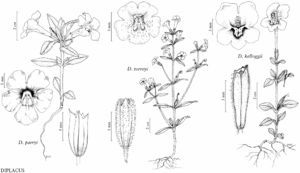Difference between revisions of "Diplacus kelloggii"
Phytoneuron 2012-39: 32. 2012.
FNA>Volume Importer |
imported>Volume Importer |
||
| (6 intermediate revisions by 2 users not shown) | |||
| Line 10: | Line 10: | ||
|special_status={{Treatment/ID/Special_status | |special_status={{Treatment/ID/Special_status | ||
|code=F | |code=F | ||
| − | |label= | + | |label=Illustrated |
}}{{Treatment/ID/Special_status | }}{{Treatment/ID/Special_status | ||
|code=E | |code=E | ||
|label=Endemic | |label=Endemic | ||
}} | }} | ||
| − | |basionyms={{Treatment/ID/ | + | |basionyms={{Treatment/ID/Basionym |
|name=Eunanus kelloggii | |name=Eunanus kelloggii | ||
|authority=Curran ex Greene | |authority=Curran ex Greene | ||
| + | |rank=species | ||
| + | |publication_title=Bull. Calif. Acad. Sci. | ||
| + | |publication_place=1: 100. 1885 | ||
}} | }} | ||
|synonyms={{Treatment/ID/Synonym | |synonyms={{Treatment/ID/Synonym | ||
|name=Mimulus kelloggii | |name=Mimulus kelloggii | ||
|authority=(Curran ex Greene) Curran ex A. Gray | |authority=(Curran ex Greene) Curran ex A. Gray | ||
| + | |rank=species | ||
}} | }} | ||
|hierarchy=Phrymaceae;Diplacus;Diplacus kelloggii | |hierarchy=Phrymaceae;Diplacus;Diplacus kelloggii | ||
| Line 37: | Line 41: | ||
|elevation=50–1500 m. | |elevation=50–1500 m. | ||
|distribution=Calif.;Oreg. | |distribution=Calif.;Oreg. | ||
| − | |discussion=<p>Diplacus kelloggii occurs in southwestern Oregon and broadly in northern California.</p> | + | |discussion=<p><i>Diplacus kelloggii</i> occurs in southwestern Oregon and broadly in northern California.</p> |
|tables= | |tables= | ||
|references= | |references= | ||
| Line 46: | Line 50: | ||
-->{{#Taxon: | -->{{#Taxon: | ||
name=Diplacus kelloggii | name=Diplacus kelloggii | ||
| − | |||
|authority=(Curran ex Greene) G. L. Nesom | |authority=(Curran ex Greene) G. L. Nesom | ||
|rank=species | |rank=species | ||
| Line 60: | Line 63: | ||
|publication title=Phytoneuron | |publication title=Phytoneuron | ||
|publication year=2012 | |publication year=2012 | ||
| − | |special status= | + | |special status=Illustrated;Endemic |
| − | |source xml=https:// | + | |source xml=https://bitbucket.org/aafc-mbb/fna-data-curation/src/2e0870ddd59836b60bcf96646a41e87ea5a5943a/coarse_grained_fna_xml/V17/V17_1394.xml |
|genus=Diplacus | |genus=Diplacus | ||
|species=Diplacus kelloggii | |species=Diplacus kelloggii | ||
Latest revision as of 19:30, 5 November 2020
Herbs, annual. Stems erect to ascending, 10–310(–370) mm, glandular-puberulent and/or glandular-pubescent. Leaves usually basal, sometimes basal and cauline, relatively even-sized; petiole absent, larger with petiole-like extension; blade obovate to elliptic, (4–)6–40(–52) × (2–)3–17(–26) mm, margins entire or crenate, plane, apex obtuse, surfaces often pubescent. Pedicels 2–6(–10) mm in fruit, usually twisting to invert calyx. Flowers 2 per node, or 1 or 2 per node on 1 plant, chasmogamous. Calyces distinctly asymmetrically attached to pedicel, not inflated in fruit, (7–)8–16(–17) mm, densely glandular-puberulent or glandular-pubescent, lobes subequal, apex obtuse, ribs purplish, intercostal areas whitish. Corollas: throat dark purple, golden yellow at base with reddish speckling, limb magenta to reddish purple, lateral adaxial lobes each with a dark purple basal spot, palate ridges golden yellow, tube-throat (13–)20–45(–50) mm, limb 10–18 mm diam., bilabiate, abaxial lip smaller than adaxial. Anthers (distal pair) exserted, glabrous. Styles densely glandular-puberulent distally. Stigmas exserted, lobes unequal, abaxial 4–5 times adaxial. Capsules 6–12(–13) mm, indehiscent. 2n = 18.
Phenology: Flowering Mar–Jun.
Habitat: Near water runoff areas, away from seeps or other areas with prolonged moisture.
Elevation: 50–1500 m.
Discussion
Diplacus kelloggii occurs in southwestern Oregon and broadly in northern California.
Selected References
None.
